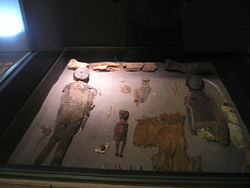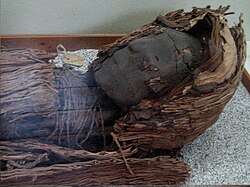Chinchorro mummies
Many ancient cultures of fishermen existed, tucked away in the arid river valleys of the Andes, but the Chinchorro made themselves unique by their dedicated preservation of the dead.The Chinchorro culture settlements and artificial mummification process in Arica and Parinacota were declared a World Heritage Site by UNESCO in 2021.[2] While many cultures throughout the world have sought to focus on preserving the dead elite, the Chinchorro tradition performed mummification on all members of their society, making them archaeologically significant.The decision of egalitarian preservation is proven in the mummification of the relatively less productive members of society (meaning those who could not contribute to the welfare of others; the elderly, children, infants and miscarried fetuses).[3] Morro-I, at the base of the Morro de Arica, revealed 96 bodies at the unstratified (i.e., there are no discernible layers of stratigraphy, hindering relative dating techniques), mostly loose sand at the slope of the hill.[7] A more commonly accepted theory is that there was an ancestor cult of sorts,[8] since there is evidence of both the bodies traveling with the groups and placed in positions of honor during major rituals and a delay in the final burial itself.[9] Also, the bodies (which were always found in the extended position) were elaborately decorated and colored (even later repainted), and are thought to be reinforced and stiffened in order to be carried on reed litters and consequently displayed.[4] However, since the society is a preceramic one, as well as slightly nomadic, it is somewhat difficult to determine through archaeological records the reasons why the Chinchorro felt the need to mummify the dead.Salts halt bacterial growth; the hot, dry conditions facilitate rapid desiccation, evaporating all bodily fluids of the corpses.It has been suggested by environmentalists that the incredible preservation of these mummies is also influenced by the pedogenic (the evolution of soil) creation of clays and gypsum, which act as cementing agents, and the latter as a natural desiccant.[13] Artisans no longer removed the organs of the dead; instead a thick coat of mud, sand and a binder like egg or fish glue was used to cover the bodies.

San Miguel de AzapaUNESCO World Heritage SiteLocationSessionmummifiedSouth AmericanChinchorro cultureEgyptianAtacama DesertmiddenseafoodArica and ParinacotaWorld Heritage SiteUNESCOmummificationelderlychildreninfantsfetusesembalmerRadiocarbon datingLas Vegas cultureValdivia cultureEcuadorNorte Chico civilizationMax UhleMorro de Aricastratigraphymitochondrial haplogroup A2Bernardo ArriazaSmithsonianbody cavitypedogenicgypsummorticiansBurial ritualCultural periods of PeruMummy JuanitaGuillén, S. E.ChungaraWayback MachineWorld Heritage SitesChurches of ChiloéValparaísoHumberstone and Santa Laura Saltpeter WorksInca road systemRapa Nui National ParkSewell Mining TownArgentinaBoliviaColombiaRoyalsOfficials, nobles, and commonersGuanche mummiesMuisca mummiesPhilippinesCommunistTarim mummiesFire MummiesMaronite mummiesBog bodiesAztec mummiesMummies of GuanajuatoBuddhist mummySokushinbutsuAnimal mummyList of mummiesDNA-testedQilakitsoqSaltmenMummification MuseumExcerebrationForgeriesMummy paperEmbalmingIncorruptibilityPlastinationProsection